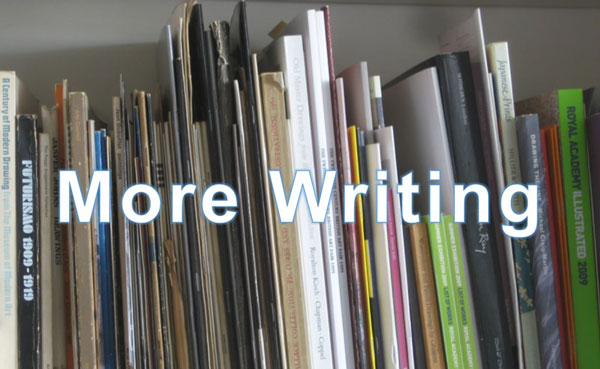David Royle
Catalogue notes from the PM Gallery Exhibition
London 2001
London 2001
This exhibition is selected from a much larger body of work made over the last twenty years or so and can be summarised into seven groups: Hothouse and Garden, Wasteland, Le Déjeuner sur l’Herbe, Oasis, Orpheus, Elemental Paintings, and Elemental Interiors. Almost everything I have painted will relate to one or more of these groups so they should offer a ready point of access to most of my other work.
David Royle, January 2001
David Royle, January 2001
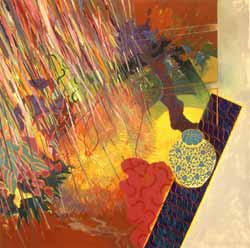
Hothouse and Garden
Late in the 1970’s I went into the hothouses at Kew gardens to make some drawings. My central aim was to understand structure and character. My drawings involved counting, slicing imaginary cross-sections, noting sequences. I looked at branching patterns: symmetrical, alternate, spiral. Patterns of veining on leaves. Colours were noted: dusty cobalt green, bursting pods of magenta tissue-thin flowers. Concentrated looking "internalised" this vegetable world. I could then re-invent from first principles, making a world in paint, with more than half an intuition that somewhere, up an obscure mountain pass or in an Amazonian backwater, close counterparts to my invention might be flourishing in reality. Working this way more general themes could become central: abundance and bursting energy, and death and decay. With the death of my father and the birth of my son I saw these processes at close quarters. This awareness is the expressive territory of these paintings and of many more to follow.
The allusiveness of the visual elements is also developing here, as is the materiality of the paint. The rain in "Rain, Garden, Chinese Jar" is painted rain, or, more accurately perhaps, raining paint. Following these paintings, throughout the early and mid nineteen-eighties, I worked deliberately to expand my range. I intuitively developed imagery from a variety of sources. I made paintings of death and life, of patterned confined regularity and gestural painterly freedom, paintings related to cancer, to birth and to burgeoning growth.
Late in the 1970’s I went into the hothouses at Kew gardens to make some drawings. My central aim was to understand structure and character. My drawings involved counting, slicing imaginary cross-sections, noting sequences. I looked at branching patterns: symmetrical, alternate, spiral. Patterns of veining on leaves. Colours were noted: dusty cobalt green, bursting pods of magenta tissue-thin flowers. Concentrated looking "internalised" this vegetable world. I could then re-invent from first principles, making a world in paint, with more than half an intuition that somewhere, up an obscure mountain pass or in an Amazonian backwater, close counterparts to my invention might be flourishing in reality. Working this way more general themes could become central: abundance and bursting energy, and death and decay. With the death of my father and the birth of my son I saw these processes at close quarters. This awareness is the expressive territory of these paintings and of many more to follow.
The allusiveness of the visual elements is also developing here, as is the materiality of the paint. The rain in "Rain, Garden, Chinese Jar" is painted rain, or, more accurately perhaps, raining paint. Following these paintings, throughout the early and mid nineteen-eighties, I worked deliberately to expand my range. I intuitively developed imagery from a variety of sources. I made paintings of death and life, of patterned confined regularity and gestural painterly freedom, paintings related to cancer, to birth and to burgeoning growth.
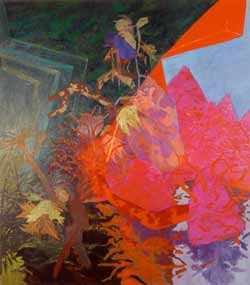
Wasteland
The first of the "Wasteland" canvasses was painted in 1986. This wasteland is a stressed and urban place. Surrounded by the energetic boom of the nineteen-eighties many small things began to catch my attention. There seemed to be more "screamers" on the streets, unfortunates whose inner dialogue had broken its bounds and spilled into public, shouting at cars or conducting loud companionless conversations on the pavements. I noticed urban decay, signs of disintegration. Drunks beat each other bloody and senseless in the local park. Abroad, the "necklace" killings in South Africa infiltrated my imagination. All this gradual accumulation stewed like imaginative compost and from it sprouted the "Wasteland" paintings.
There are echoes of war photography, industrial dereliction, single figures in extremis or showing the more bestial of human aspects. An old painter friend saw the paintings. "They seem to come from a long way back", he commented. Some time later I finally realised the personal connections which he had intuitively sensed. Until I was eight I lived in Manchester at a time when the post-war cotton slump hit the mills and working-class districts up towards Oldham. Another kind of dereliction added to the wartime damage. This was my childhood landscape, the cinders-and-scrub land near the choked canal where Granny Greenteeth waited to drag us down if we touched the water. One strong set of reactions had fed off another. The power of the "Wasteland" imagery drew from this dual source although the earlier part had remained unconscious until some time after the moment of painting. It confirmed my trust in imaginative intuition, judging the quality of the creative project from its internal "feel" in advance of its making, sensing the power of its associations without necessarily being fully conscious of them. Quite often personal expression seems very able to take care of itself.
The first of the "Wasteland" canvasses was painted in 1986. This wasteland is a stressed and urban place. Surrounded by the energetic boom of the nineteen-eighties many small things began to catch my attention. There seemed to be more "screamers" on the streets, unfortunates whose inner dialogue had broken its bounds and spilled into public, shouting at cars or conducting loud companionless conversations on the pavements. I noticed urban decay, signs of disintegration. Drunks beat each other bloody and senseless in the local park. Abroad, the "necklace" killings in South Africa infiltrated my imagination. All this gradual accumulation stewed like imaginative compost and from it sprouted the "Wasteland" paintings.
There are echoes of war photography, industrial dereliction, single figures in extremis or showing the more bestial of human aspects. An old painter friend saw the paintings. "They seem to come from a long way back", he commented. Some time later I finally realised the personal connections which he had intuitively sensed. Until I was eight I lived in Manchester at a time when the post-war cotton slump hit the mills and working-class districts up towards Oldham. Another kind of dereliction added to the wartime damage. This was my childhood landscape, the cinders-and-scrub land near the choked canal where Granny Greenteeth waited to drag us down if we touched the water. One strong set of reactions had fed off another. The power of the "Wasteland" imagery drew from this dual source although the earlier part had remained unconscious until some time after the moment of painting. It confirmed my trust in imaginative intuition, judging the quality of the creative project from its internal "feel" in advance of its making, sensing the power of its associations without necessarily being fully conscious of them. Quite often personal expression seems very able to take care of itself.
"Wasteland III: The Dappled Man"
1986 84 x 74ins 213.4 x 188cm
Oil on Cotton
1986 84 x 74ins 213.4 x 188cm
Oil on Cotton
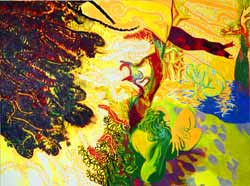
"Le Déjeuner sur l'Herbe III"
1990 54 x 72ins 137.2 x 183cm
Oil on Cotton
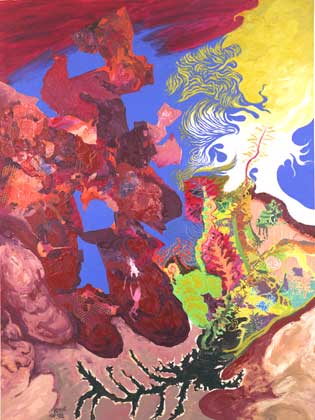
Oasis
During 1991 and 1992 I painted the ten canvasses of the "Oasis" series. In general, these paintings are places of tension between expansion, life and abundance, and ruin, pressure and decay - the balance often shifting from one canvas to the next. The "Wasteland" seems to be pressing on the "Garden".
I think that we see with our understanding and, to a large extent, only what we know. We understand different things in our visual field in different ways. Following this, it seemed to me that painting could have variations of visual mode across the surface, which would, in part evoke great shifts of scale. I wanted the materiality of the paint to do a lot of the work, to embody rather than illustrate. So its physical range could go from the very thick to finely constructed concentrations of detail. The figurative allusions could follow, with microscopic to macroscopic scale shifts, could in some parts be relatively descriptive and in other parts visually metaphorical, could build a surface of rich comparisons: dry spiky edges, rich heavy dollops and pours, watery rhythms, areas of pressing visual weight and volcanic bursts of vegetable energy.
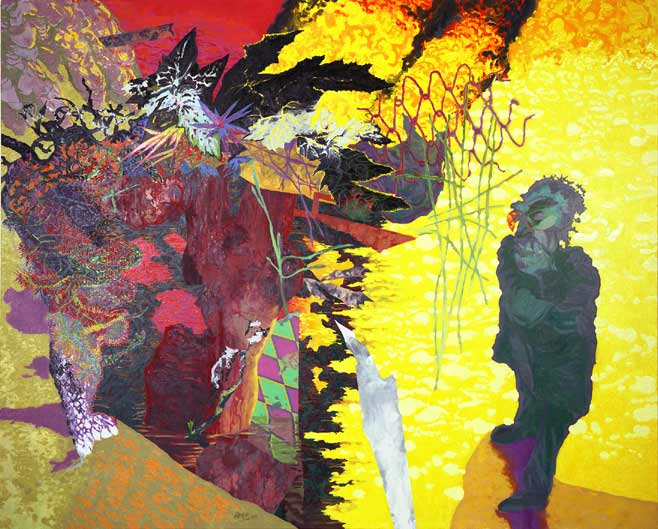
Orpheus
In 1994, out of the "Oasis" paintings emerged the hotter, more burnt place of the "Orpheus" paintings, now showing the trail of some human violence. An inverted hanging figure became entangled in the vegetation by over-shaded debris-strewn water. There is here a thematic echo of the solitary figures in some of the "Wasteland" paintings and a passing hommage to Goya.
Since 1992 I had also begun to make quite small paintings, initially as painted studies, but later as complete works in their own right. In these the internal scale and paint marks had to be adjusted accordingly. When this experience was built into the larger surfaces it extended the range of the paintings hugely. In them there is some imagistic and spatial ambiguity which I think of as being in-built alternatives. On an imagistic level this allows a visual "slippage" between one interpretative way of seeing and another. Another associated visual "slippage" is more formal, or rather, expressive at the level of painterly construction. Spatial priorities move as the viewer’s attention moves, from one part of the surface to another. Parts move "forward" and drop "back" in the attention. The colour, edge and physical paint-contrasts across the surface variously let the attention slip and move without a strict spatial hierarchy as though the flat painted things were coming in and out of our constantly shifting optical focus. The intention is to allow the eye to roam over the surface, resting where it will to make its own interpretative sense of the shapes and colours, just as we are free to visually negotiate and interpret the wider world outside the borders of the canvas.
In 1994, out of the "Oasis" paintings emerged the hotter, more burnt place of the "Orpheus" paintings, now showing the trail of some human violence. An inverted hanging figure became entangled in the vegetation by over-shaded debris-strewn water. There is here a thematic echo of the solitary figures in some of the "Wasteland" paintings and a passing hommage to Goya.
Since 1992 I had also begun to make quite small paintings, initially as painted studies, but later as complete works in their own right. In these the internal scale and paint marks had to be adjusted accordingly. When this experience was built into the larger surfaces it extended the range of the paintings hugely. In them there is some imagistic and spatial ambiguity which I think of as being in-built alternatives. On an imagistic level this allows a visual "slippage" between one interpretative way of seeing and another. Another associated visual "slippage" is more formal, or rather, expressive at the level of painterly construction. Spatial priorities move as the viewer’s attention moves, from one part of the surface to another. Parts move "forward" and drop "back" in the attention. The colour, edge and physical paint-contrasts across the surface variously let the attention slip and move without a strict spatial hierarchy as though the flat painted things were coming in and out of our constantly shifting optical focus. The intention is to allow the eye to roam over the surface, resting where it will to make its own interpretative sense of the shapes and colours, just as we are free to visually negotiate and interpret the wider world outside the borders of the canvas.
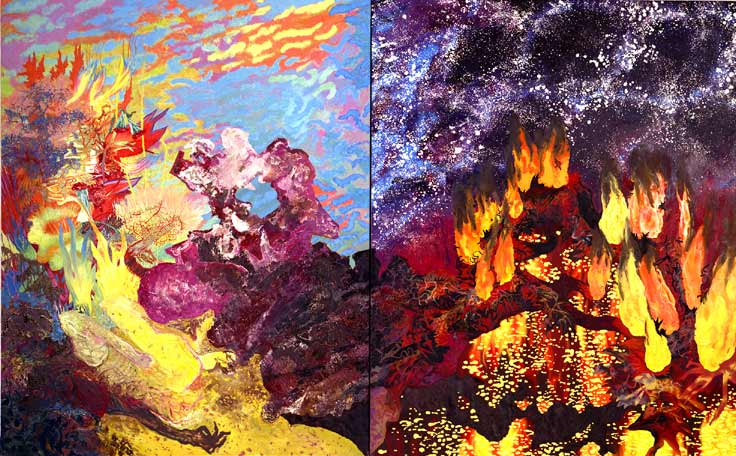
Elemental Paintings
From early in 1996 I made increased use of the diptych format. The presence of the physical split between the two butting canvasses offers various comparative possibilities: surfaces different in their colour, construction and imagery can be set in relationship, two views of an idea within one whole, or two thematically continuous parts, one perhaps more close and intimately viewed, the other implying a larger overview. This format also brings with it all the expressive tensions of joining and separating. The physical division of the surface is echoed in some of the internal space-chopping painted edges, particularly in the imagery of reflecting water and angular weirs. Here is a lot of inter-surface penetration: human figures or debris breaking the rhythmical reflecting surfaces which also confine more expansive vistas, illuminated skies of intense blue or infinities of spattered stars. Although they are not a discrete series, I think of these paintings as "Elemental" because they move from the intimate rendering of small things to the expansiveness of more infinite spaces. And the imagery is primal: earth, fire, water, bursts of life and colour and cold indifferent far distances, the cycle of beginnings and of endings, the imagery of large forces.
From early in 1996 I made increased use of the diptych format. The presence of the physical split between the two butting canvasses offers various comparative possibilities: surfaces different in their colour, construction and imagery can be set in relationship, two views of an idea within one whole, or two thematically continuous parts, one perhaps more close and intimately viewed, the other implying a larger overview. This format also brings with it all the expressive tensions of joining and separating. The physical division of the surface is echoed in some of the internal space-chopping painted edges, particularly in the imagery of reflecting water and angular weirs. Here is a lot of inter-surface penetration: human figures or debris breaking the rhythmical reflecting surfaces which also confine more expansive vistas, illuminated skies of intense blue or infinities of spattered stars. Although they are not a discrete series, I think of these paintings as "Elemental" because they move from the intimate rendering of small things to the expansiveness of more infinite spaces. And the imagery is primal: earth, fire, water, bursts of life and colour and cold indifferent far distances, the cycle of beginnings and of endings, the imagery of large forces.
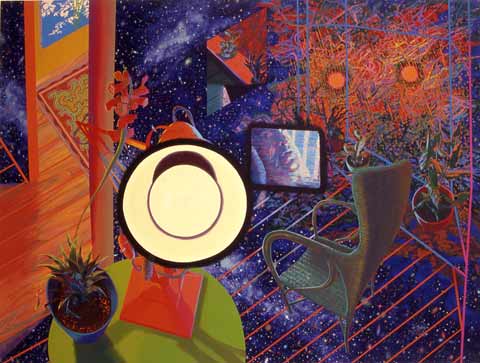
Elemental Interiors
A well-worn metaphor in ordinary conversation is to talk about missing the last piece of a (jigsaw) puzzle, or perhaps, finally possessing the last piece and completing the picture. On several occasions I have gone back through the stacks of earlier work and surprised myself with the rediscovery of a half-forgotten painting which somehow stands out, rather solitary in its preoccupations. These paintings are often isolated precursors of larger developments. It is as though the common puzzle metaphor were reversed: they are like a single piece waiting for all the other pieces to arrive. More painterly experiences and thoughts must accumulate and then a run of work can begin which expands from the earlier, isolated, painting. This has happened enough times for me to be curious about any painting which appears relatively different in approach from the works made immediately around it. Made early in 1997 "Studio - Interior" is such a work. Two years later I saw its fuller potential, and this was the beginning of the "Elemental Interiors". I remember that I had wanted to make a painting which combined the vastness of the diptychs with a more intimate space, which might also imply the idea of a subjective interior, possibly alluding to the process of painting itself. It needed to be more compressed than the diptychs. By "looking through" the walls of the interior and opening-up the "back" plane to infinite space I could fit all I wanted into the painting. Instead of the big shifts of scale being adjacent they became layered and simultaneous.
In the paintings which followed, to articulate the appropriate separating and merging of all the layered elements, a sharper "focus" in the edges and in the colour relationships became necessary. The idea of near and far gained in importance and this, in its turn, raised the idea of the implied subjective viewpoint in these paintings. This suggested the added scale contrast of enlarged, extreme close-ups, and the combining of composite spaces within an overall abstracted visual structure, often linear and "transparent".
These paintings bring the work up to 2000 and to the ideas which are being made material in the studio right now.
A well-worn metaphor in ordinary conversation is to talk about missing the last piece of a (jigsaw) puzzle, or perhaps, finally possessing the last piece and completing the picture. On several occasions I have gone back through the stacks of earlier work and surprised myself with the rediscovery of a half-forgotten painting which somehow stands out, rather solitary in its preoccupations. These paintings are often isolated precursors of larger developments. It is as though the common puzzle metaphor were reversed: they are like a single piece waiting for all the other pieces to arrive. More painterly experiences and thoughts must accumulate and then a run of work can begin which expands from the earlier, isolated, painting. This has happened enough times for me to be curious about any painting which appears relatively different in approach from the works made immediately around it. Made early in 1997 "Studio - Interior" is such a work. Two years later I saw its fuller potential, and this was the beginning of the "Elemental Interiors". I remember that I had wanted to make a painting which combined the vastness of the diptychs with a more intimate space, which might also imply the idea of a subjective interior, possibly alluding to the process of painting itself. It needed to be more compressed than the diptychs. By "looking through" the walls of the interior and opening-up the "back" plane to infinite space I could fit all I wanted into the painting. Instead of the big shifts of scale being adjacent they became layered and simultaneous.
In the paintings which followed, to articulate the appropriate separating and merging of all the layered elements, a sharper "focus" in the edges and in the colour relationships became necessary. The idea of near and far gained in importance and this, in its turn, raised the idea of the implied subjective viewpoint in these paintings. This suggested the added scale contrast of enlarged, extreme close-ups, and the combining of composite spaces within an overall abstracted visual structure, often linear and "transparent".
These paintings bring the work up to 2000 and to the ideas which are being made material in the studio right now.
"Rain, Garden, Chinese Jar"
1982 67 x 67ins 170.2 x 170.2cm
Oil on Linen
"Oasis VIII"
1992 72 x 54ins 183 x 137.2cm
Oil on Linen
1992 72 x 54ins 183 x 137.2cm
Oil on Linen
"Fiery Orpheus and Witness"
1995 63 x 78ins 106 x 198cm
Oil on Linen
1995 63 x 78ins 106 x 198cm
Oil on Linen
"Times Change I"
1996 60 x 96ins 152.4 x 244cm
Oil on Linen
1996 60 x 96ins 152.4 x 244cm
Oil on Linen
"Inside on a Wild Night"
2000 54 x 73ins 137.2 x 183cm
Oil on Linen
2000 54 x 73ins 137.2 x 183cm
Oil on Linen
Le Déjeuner sur l'Herbe
Pinned-up in my studio, among other photographs and cards, was a reproduction of Manet's "Le Déjeuner sur l'Herbe". Early in 1990, after glancing at it over a number of months I made some exploratory drawings. Constructively stealing another artist’s work as a starting point, can have a liberating effect on formal invention. As the subject-matter is not your own there is not the same subjective investment in matching outcome to intention. Throughout the whole body of work associated with it the Manet acted like a catalyst, exciting and fusing ideas which had been at the back of my visual mind, unconnected, for some time. Working from this "found" imagery brought an increased sense of visual play into the inventive mixture, allowing new combinations to form. Emerging here in these paintings were newer ideas about surface, scale, imagery, the physical-perceptual process of looking, the movement of attention, the materiality of paint and, particularly, colour. The optical intensity of certain colour combinations and how they can evoke sensations of bright illumination. All my subsequent work took-up and developed these ideas.
Pinned-up in my studio, among other photographs and cards, was a reproduction of Manet's "Le Déjeuner sur l'Herbe". Early in 1990, after glancing at it over a number of months I made some exploratory drawings. Constructively stealing another artist’s work as a starting point, can have a liberating effect on formal invention. As the subject-matter is not your own there is not the same subjective investment in matching outcome to intention. Throughout the whole body of work associated with it the Manet acted like a catalyst, exciting and fusing ideas which had been at the back of my visual mind, unconnected, for some time. Working from this "found" imagery brought an increased sense of visual play into the inventive mixture, allowing new combinations to form. Emerging here in these paintings were newer ideas about surface, scale, imagery, the physical-perceptual process of looking, the movement of attention, the materiality of paint and, particularly, colour. The optical intensity of certain colour combinations and how they can evoke sensations of bright illumination. All my subsequent work took-up and developed these ideas.

